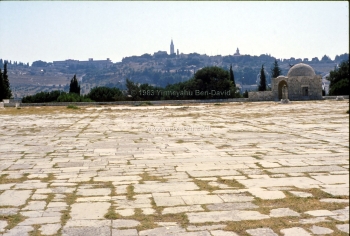
 |
Updated: 2025.02.11![]()
 0350x263.jpg) |
Mi•zᵊbeiꞋakh; altar.
Among all ancient peoples, their מִזבֵּחַ was the dining table of their deity—and all other altars were dining tables of rival demons. A diner's religion and
"The [shul•khânꞋ] upon which food is served became identified in Jewish traditional thought with the [מִזבֵּחַ of the Beit ha-Miq•dâshꞋ]. 'When the [Beit ha-Miq•dâshꞋ] stood, sacrifices would secure [ki•purꞋ] for an individual; now his [shul•khânꞋ] does' (Tal•mudꞋ Bav•liꞋ Ma•sëkꞋët Khagig•âhꞋ 27a), was the way it was put by one Talmudic Sage.
(This symbolic identification explains the widespread custom among Jews of not sitting down upon a [shul•khânꞋ]; it explains the custom among some of sprinkling salt upon the first morsel of bread eaten—just as was required of the ancient sacrifices; or of removing all knives from the [shul•khânꞋ] before the recitation of grace because knives and swords—symbols of war and violence—were forbidden on the [מִזבֵּחַ], a symbol of peace; it is even one of the reasons given for the ritual washing before the meal—which is done not only for reasons of cleanliness but also to symbolize the ritual purity required of the [Kohan•imꞋ] when they officiated at the offerings.)
Even during the meal we are directed to raise the level of the conversation, as befitting the sacred symbolism of the [shul•khânꞋ]. 'Three who eat together and no words of Tor•âhꞋ are exchanged, it is as though they ate from pagan offerings… But if three have eaten at a [shul•khânꞋ] and spoke words of Tor•âhꞋ, it is as though they ate at the [Shul•khânꞋ] of [י--ה] (Ma•sëkꞋët Âv•otꞋ 2.4). The Birk•atꞋ ha-Mâ•zonꞋ, the grace after meals is in fact a minimal satisfaction of this requirement. But the imagery is always in terms of [a מִזבֵּחַ]; and the very act of eating is [thereby elevated to] a form of offering to [י--ה], at which appropriate [tᵊphil•otꞋ] are recited before and after…
As it was forbidden to bring certain animals upon the [מִזבֵּחַ] of [י--ה], so is it forbidden to do so upon the [Shul•khânꞋ]." (Donin, R. Hayim Halevy, To Be a Jew (New York: Basic Books, 1972), p. 101).
 |
| Har ha-• |
"In the days of the [Beit ha-Miq•dâshꞋ], the מִזבֵּחַ served to [provide ki•purꞋ] for us; now it is our table that [provides ki•purꞋ] for us" (Tal•mudꞋ Bav•liꞋ Ma•sëkꞋët Khagig•âhꞋ 27a)." While a superficial understanding of this statement is patently false (since
See also Shul•khânꞋ (table).
Pay it forward (Quote & Cite):
| Yirmeyahu Ben-David. Mizbeiakh (2025.02.11). Netzarim Jews Worldwide (Ra'anana, Israel). https://www.netzarim.co.il/ (Accessed: MM DD, YYYY). |
 |
 |